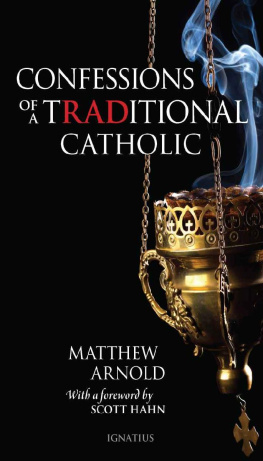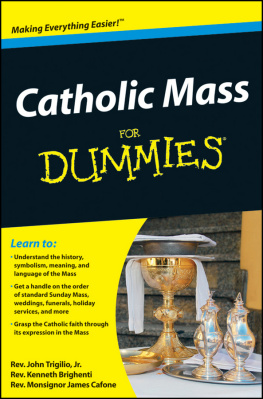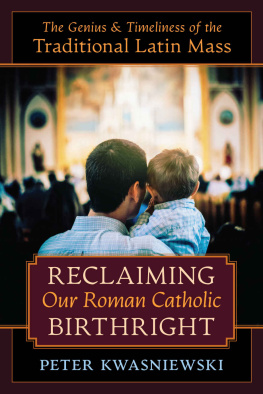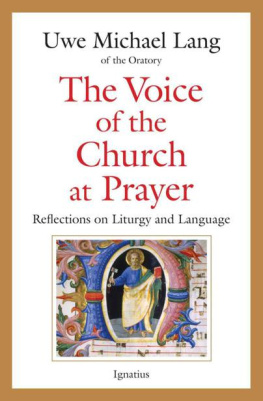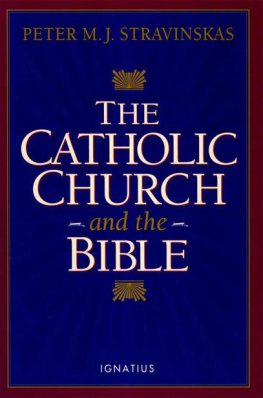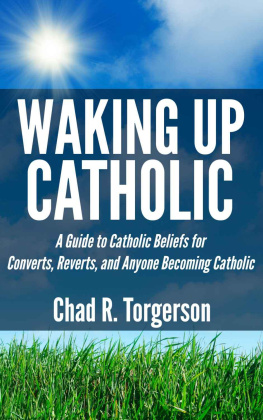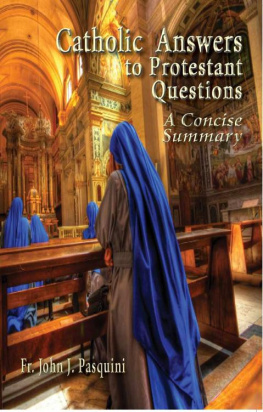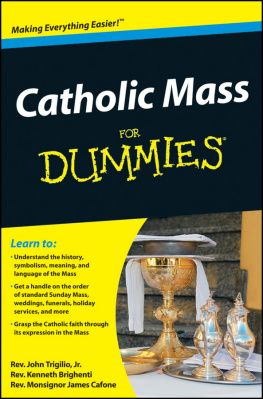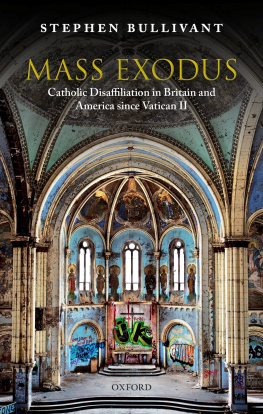CONFESSIONS OF A
TRADITIONAL CATHOLIC
MATTHEW ARNOLD
CONFESSIONS OF
A TRADITIONAL
CATHOLIC
IGNATIUS PRESS SAN FRANCISCO
Unless otherwise indicated, Scripture quotations are from Revised Standard Version of the BibleSecond Catholic Edition (Ignatius Edition) copyright 2006 National Council of the Churches of Christ in the United States of America. Used by permission. All rights reserved worldwide.
Scripture texts marked (DRV) are taken from the Douay-Rheims Bible, 1899 American Edition Version .
Excerpts from the English translation of the Catechism of the Catholic Church , Second Edition, 1994, 1997, 2000 by Libreria Editrice VaticanaUnited States Catholic Conference, Washington, D.C. All rights reserved.
Excerpts from the English translation of The Roman Missal 2010, International Commission on English in the Liturgy Corporation. All rights reserved.
Cover design by Davin Carlson
2017 by Ignatius Press, San Francisco
All rights reserved
ISBN 978-1-62164-155-1 (PB)
ISBN 978-1-68149-784-6 (EB)
Library of Congress Control Number 2017945960
Printed in the United States of America
To Blessed Mary of Good Success:
Star of the Sea and loving helper
of the Christian people
Many of those who are humiliated
are not humble.
Some react to humiliation with anger,
others with patience, and others
with freedom.
The first are culpable, the next harmless,
the last just.
Saint Bernard of Clairvaux
CONTENTS
FOREWORD
My friendship with Matthew Arnold arose, as friendships do, from many shared experiences. We both discovered the Catholic faith in adulthoodand fell in love with it. We both were drawn to tradition. We both determined, very soon after conversion, to dedicate our work, full-time, to the apostolate.
In fact, soon after meeting, we began working together. We broadcast many hours of live radio together. We spoke together at conferences. In all our collaboration we tried to communicate the beauty of tradition to an audience, mostly Catholic, who knew little or nothing about their own heritage. They couldnt number the Sacraments or name the commandments. They were strangers to the great saints, from Ignatius of Antioch and Augustine to Thomas Aquinas and Alphonsus Liguori. They were unaware of their obligation to attend Mass on Sundays and Holy Days of Obligation. If they thought about fasting at all, they viewed it as something done by Muslims and Jews, but not Catholics.
So with Matthew Arnold I shared a deep sorrow that so many peoplewhole generations within the Churchhad been deprived of the riches of Catholic tradition. Through the last half century even the clergy experienced a disconnect, a rupture, a break with the past.
Such sorrow can lead to disaffection, if we let it. And not a few tradition-minded Catholics have let itand let themselves lose their ardor for the faith, the Church, and the apostolate.
Not so Matthew Arnold. He sensed the danger, and he knew where one should always turn in danger. He went to the Blessed Virgin Mary, who led him to a greater understanding and love for all her children in the Church. He came to see that tradition and development are not opposed principles. He came to know that its not either-orits both-and.
That, in fact, is the truly and traditionally Catholic approach.
This book is Matthew Arnolds story. Its not an argument. Its the beautiful story of how he found, and then lost, and then rediscovered the joy of Catholic tradition. Its the page-turning tale of how he stumbled again upon the peace that surpasses all understanding, even the clear understanding of our historical situation, which is admittedly dire.
This book is a much-needed expression of hope for our timehope with its eyes wide open.
Scott Hahn, PhD
Steubenville, 2016
INTRODUCTION
No matter how normal a Catholic you are, I suspect you have heard about Catholic Traditionalism. Maybe you have friends or family that assist at the Extraordinary Form of the Mass, also known as the Traditional Latin Mass. Maybe a church in your diocese offers this Mass at least sometimes. Maybe youve heard of the Society of Saint Pius X or other Traditionalist groups that operate outside the official structure of the Church and wondered what it was all about.
Let me say at the outset that my journey into the world of Traditionalist Catholicism was not motivated by any personal animus toward Vatican II or the New Mass. As an adult convert, I had virtually no experience whatsoever of the pre-conciliar Church. A former New Age practitioner and Hollywood insider, I was only received into the Roman Catholic Church in 1996. Consequently, I had no nostalgia for the Latin language in general or the Traditional Mass in particular.
My Catholic formation was what many would call solid and orthodox. By 1998 I was working full-time in Catholic evangelization as an apologist, public speaker, and EWTN Radio personality. Pope Saint John Paul II was the first pope I ever knew, and the vernacular Mass, complete with lay lectors and guitar music (sometimes provided by me), was the liturgy that I embraced. I had no trouble back then reconciling the New Mass with the traditional doctrines of the Church, nor do I now.
So how did I wind up spending years at an Independent Traditionalist chapel outside the jurisdiction of the local bishop? Why did I eventually return to full communion with the Church? What did I learn on the way? I am writing this little book to provide the answers and, I hope, to promote greater understanding and unity within the Body of Christ.
Matthew Arnold
Garden Grove, 2017
Chapter One
IN THE BEGINNING
It all started with a question about the Eucharist. My wife, Betty, and I were married in the Church in 1991. I began attending Mass with her even before then, but never felt any particular urge to become Catholic. During our marriage preparation, I technically should have enrolled in the Rite of Christian Initiation of Adults (RCIA) butpresumably because I had no desire to convertthe priest who helped us through the process thought it better to delay my instruction. However, since part of the deal for getting married in the Church is to raise the children in the faith, he made me promise to take instruction when the kids come along and start asking questions. Two years later, when we brought our first child, Macklin, home from the hospital, Betty immediately asked if I was going to enroll in RCIA. I replied, Its not like he has questions. He cant even hold up his own head! But it didnt take long.
I continued attending Mass with Betty and, now, little Macklin. When he was not quite three years old, Mack asked Mommy why everyone went to Communion except him and Daddy. Betty told him, To receive Communion, you have to understand that the Host is Jesus. Macklin thought about this for a moment and then asked, If thats Jesus, where is His hair? Her response? Go ask your father. Obviously caught flat-footed, I remarked that a certain priest at our parish, Father Magister, seemed very sincere and, if he was the teacher, I would be willing to take the course. That was Sunday evening. On Monday morning Betty called the rectory to ask when RCIA classes began. Wouldnt you know it was that very Thursday? And who was the instructor? You guessed it.
DONT TALK TO ME ABOUT IT
As my RCIA instructor, Father Magister was something of a perfect storm. A former Fundamentalist, he converted to Catholicism, answered the call to the priesthood, studied in Rome, and finally was ordained by Pope Saint John Paul II himself! It was a great blessing for me that Father wound up teaching RCIA at our little parish, Saint Ubiquitous.
At the first class, we went around the room introducing ourselves and explaining why we were taking the course. The responses were what you might expect: Im Bob and Im getting married in the Church; Im Sue and I never got confirmed. When my turn came I said, My name is Matthew and I have no intention of converting. Im only here to find out what you people believe. I was never much of a joiner.
Next page
